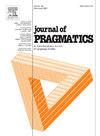Comparison between Chinese and Japanese self-praise on social media
IF 1.7
1区 文学
0 LANGUAGE & LINGUISTICS
引用次数: 0
Abstract
Self-praise is attracting increasing attention in pragmatics and discourse studies. However, Japanese self-praise has rarely been investigated, particularly in online communication. In addition, few studies have examined self-praise from a cross-cultural pragmatics perspective. Therefore, this study compares Chinese and Japanese self-praise on social media, based on 300 instances of Chinese self-praise on Weibo and 300 instances of Japanese self-praise on Twitter. The findings show that the Chinese and Japanese netizens both produced three categories of self-praise: explicit self-praise without modification, modified explicit self-praise, and implicit self-praise, in the same order of decreasing frequency. The Chinese netizens most frequently employed the modified explicit self-praise strategies “disclaimer”, “praise from a third party”, and “referring to the group”, while their Japanese counterparts preferred the modified explicit self-praise strategy “change of praise focus” and the implicit strategy “self-praise as sharing”. The study discusses the similarities and differences between these two groups’ social media self-praise, particularly with regard to the affordances of social media and pragmatic norms in the two cultures.
中国人和日本人在社交媒体上的自我表扬比较
自我赞扬在语用学和语篇学研究中越来越受到关注。然而,日本人的自我赞美很少被调查,尤其是在网络交流中。此外,很少有研究从跨文化语用学的角度来考察自我赞扬。因此,本研究以300例中国人在微博上的自我表扬和300例日本人在Twitter上的自我表扬为基础,比较了中国人和日本人在社交媒体上的自我表扬。结果表明,中国网民和日本网民都产生了三种类型的自我表扬,即不加修饰的外显自我表扬、修饰的外显自我表扬和内隐自我表扬,其频率递减的顺序相同。中国网民最常使用的是修改后的外显自我表扬策略“免责”、“第三方表扬”和“参照群体”,而日本网民则更喜欢修改后的外显自我表扬策略“改变表扬焦点”和内隐自我表扬策略“分享式自我表扬”。该研究讨论了这两个群体在社交媒体上自我赞扬的异同,特别是在两种文化中社交媒体的支持和实用规范方面。
本文章由计算机程序翻译,如有差异,请以英文原文为准。
求助全文
约1分钟内获得全文
求助全文
来源期刊

Journal of Pragmatics
Multiple-
CiteScore
3.90
自引率
18.80%
发文量
219
期刊介绍:
Since 1977, the Journal of Pragmatics has provided a forum for bringing together a wide range of research in pragmatics, including cognitive pragmatics, corpus pragmatics, experimental pragmatics, historical pragmatics, interpersonal pragmatics, multimodal pragmatics, sociopragmatics, theoretical pragmatics and related fields. Our aim is to publish innovative pragmatic scholarship from all perspectives, which contributes to theories of how speakers produce and interpret language in different contexts drawing on attested data from a wide range of languages/cultures in different parts of the world. The Journal of Pragmatics also encourages work that uses attested language data to explore the relationship between pragmatics and neighbouring research areas such as semantics, discourse analysis, conversation analysis and ethnomethodology, interactional linguistics, sociolinguistics, linguistic anthropology, media studies, psychology, sociology, and the philosophy of language. Alongside full-length articles, discussion notes and book reviews, the journal welcomes proposals for high quality special issues in all areas of pragmatics which make a significant contribution to a topical or developing area at the cutting-edge of research.
 求助内容:
求助内容: 应助结果提醒方式:
应助结果提醒方式:


